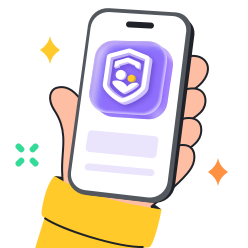Tellonym is a popular choice for teens and young adults to share their feelings, ask questions, and get anonymous answers. This social network is distinguished by its commitment to honesty without passing judgment.
However, the apps focus on anonymity can open doors to risks such as cyberbullying. In this guide, we’ll explain what Tellonym is, how it functions, and the reasons it has become popular—especially with younger users. We’ll also go over dangers anonymity possess to younger users and how to manage it.
What is Tellonym?
Tellonym is a messaging app that allows users to get and reply to messages anonymously from other users. Its main function is to help people raise issues, express their views, or offer feedback without revealing their identity. It can help users be more honest, participate in conversations they find challenging face to face, or share things they normally would not.
The app is easily accessible regardless of whether you’re an iOS, Android, or using the web version. For many, the chance to communicate without being known is truly exciting and fun. Yet, this same characteristic can cause some safety issues such as those resulting from bullying or access to inappropriate things shared online.
Is Tellonym really anonymous?
Yes, Tellonym helps people communicate anonymously, meaning the other person does not see your name or anything revealing about you. It helps people to talk openly and honestly with each other.
But there will be times when the app gathers technical information such as IP addresses or device identifiers without alerting you. Even though users can’t see this data, it supports the platform in handling hazards or responding in case of requests from the law.
How Tellonym handles users data and privacy
Though Tellonym appears to be anonymous to its users, it collects information such as the user’s IP address, name of the device they use, and their activity. Such information is often regarded as useful to enhance security measures and keep users safe.
Experienced users are given the option to manage their privacy which includes things like muting others, restricting who can contact them or deactivating surprise tells. However, it’s necessary to note that Tellonym does not allow users to see each other’s names.
What data Tellonym collects
The app may feel like a private way to talk, but it still gathers user information out of sight. The user’s device IP address, device information, and activities within the app are all included here. The data isn’t provided to users, but it lets the platform know about abuse, spam, and when extra safety precautions are needed.
User privacy controls
Built-in privacy settings on Tellonym mean that users can decide how many privacy settings they use. They can also mute people they don’t want to interact with, set up user lists, and avoid surprise tells. Though not foolproof, such tools make it possible for users to control their communication and reduce the risk of receiving unwanted messages.
Maintaining anonymity on the surface
Although Tellonym automatically collects data when users interact, it ensures that all exchanges are confidential. Unless a sender wishes to be revealed, their identity is always kept secret by the platform. While this tool is what makes the app attractive, it also causes more moderation problems and increases the need for good user privacy features.
Make sure your child has the right apps installed.
How does Tellonym work?
Once your profile is ready, others can write to you anonymously. A lot of teens use it to ask for frank advice or enjoy talking or running polls with friends. Even though using the app is straightforward, knowing how it operates can protect you and allow you to enjoy its features.
Step 1. Go to the App Store for iOS users and Google Play Store for Android users and download Tellonym.
Step 2. Connect a social profile or use your email to sign up.
Step 3. Now set up your account using your details.
Step 4. Share your unique profile link using social media or with those you know.
Step 5. Anyone who clicks on your link has the option to leave you anonymous messages.
Step 6. Open the messages and figure out if you want to respond or not.
Step 7. Modify your privacy settings to decide who can contact you.
Pros and cons of using Tellonym
Just as with any other social apps, Tellonym also has its advantages and disadvantages. The good thing about it is that it provides a platform for free and honest communication which many teens relish.
Still, those same features that draw users to the app can also create problems. Users should be aware that privacy, inappropriate content, and misuse are all serious matters related to social networks. That’s why you need to know the pros and cons of Tellonym so that you protect yourself better.
Pros of Tellonym anonymity:
- Honest feedback: Makes it easier for people to share the truth as they won’t encounter criticism. People can raise questions or say things they wouldn’t usually share.
- Personal expression: Allows users to express emotions they might not be comfortable sharing aloud, mainly if they involve emotional, social, or mental health.
- Supportive conversations: People can have open and honest conversations with others who answer them with empathy.
- Confidence boost: Allows quiet or anxious users to socialize by giving them a chance to talk with others in a relaxed way.
Cons of Tellonym anonymity:
- Hurtful messages: Anonymous chat lets some people say mean or bad things and not worry about getting in trouble.
- Cyberbullying risk: Having no identity can place teens and younger internet users at greater risk of being bullied or harassed. Lack of accountability: When people feel their activities aren’t easily traced, it allows a small percentage to behave badly.
- Toxic environment: If there is no good monitoring, the app could become a place for drama, unsafe encounters, or unhealthy messages.
Comparison: Tellonym vs Similar Apps
Many teens and young adults now use anonymous messaging apps since they can share their thoughts, report problems, and respond to questions privately. Tellonym may be the leader, but alternative tools provide similar features.
Tellonym is recognized for having a clean interface, an emphasis on anonymous Q&A, and a big community of teen users. Unique features of the app include allowing users to turn off anonymous messages, block others, filter what’s inappropriate, and reply to tells as part of a stream or feed. It creates a mix between private messaging and public Q&A for all to participate in.
Ngl
NGL is meant to be used together with Instagram. You can create a link to a question box that people can put on their Instagram Stories. Afterwards, anyone interested can react anonymously. It’s clear, fun to operate, and perfect for a laugh, but might not be reliable enough for checking messages or managing suspicious behavior on the app.
Sarahah
Sarahah was one of the first applications to become popular for receiving secret feedback. Feedback apps are different because they were designed to help people collect useful criticism for improvement at work or personally. Comments on Sarahah are not public and can’t be replied to by everyone which protects privacy.
Yolo
The app is unique for enabling users to post anonymously via Snapchat and then answer these questions in their Stories. YOLO is still criticized for not offering strong content moderation which made it to be temporarily removed from app stores after several lawsuits.
Lipsi
Using Lipsi means you can connect with strangers in your area, even though your name is hidden. It is different from others because it mixes location-based features with message services. Although the app advertises as helping users gain confidence, letting people share their location causes major safety and privacy issues for teens and younger users.
| Features | Tellonym | NGL | Sarahah | YOLO | Lipsi |
| Anonymous Messaging | √ | √ | √ | √ | √ |
| Works with Instagram | × | √ | × | × | × |
| Works with Snapchat | × | × | × | √ | × |
| Public replies to Messages | √ | × | × | × | × |
| Content filtering | √ | × | × | × | × |
| Block or report users | √ | × | × | × | √ |
| Social feed or interaction features | √ | × | × | √ | √ |
| Active development & Support | √ | √ | × | √ | √ |
| Geolocation-Based Messaging | × | × | × | × | √ |
FAQs about Tellonym
Yes, It is possible for Tellonym to generate automated tells aimed at increasing user activity when not many people are online. Most of these messages look like regular questions or commands and may be automatically produced by the system.
To remove your Tellonym account, start the app, go to your profile, and select the gear icon for settings. From within your account settings, select the option to remove your account and confirm.
Parental controls and protecting kids on Tellonym
The private setup on Tellonym can eventually lead children to dealing with discouraging or inappropriate messages. As a result, parents have to follow what’s happening and be involved in their kid’s online access. With these methods, you can guarantee your kid’s safety whenever they use apps like Tellonym to share their thoughts and feelings.
Use monitoring apps to manage your kid’s Tellonym experience
Monitoring your kids is not an easy task since it requires time and effort. For parents who are balancing parental duties with work, it can be almost impossible to always be there for your kids. That’s why you need parental control tools that are robust and can help you manage your kids more efficiently.



A simple way to manage your child’s Tellonym use is with an app like FlashGet Kids which has incredible features that can help you manage your kid’s online experience. You can watch your child’s screen and set time limits, block some apps, and track if they use dangerous keywords. It gives you the reassurance, and view you need without overstepping, helping you address anything that doesn’t look right.
Have conversations about staying safe online
It’s helpful to regularly talk with your child about how dangerous it can be to talk to strangers online. Let them know that having fun online doesn’t always mean the other person is friendly. If they tell you they’ve been upset, let them know they can always bring it up with you.
If children understand that you won’t judge them, they’ll tend to approach you whenever they experience any challenge with apps like Tellonym.
Help them use Tellonym’s safety features
Explain to your child how to open the Tellonym app’s safety settings to protect themselves better. You can mute anonymous messages, avoid unwanted users by blocking them, and hide messages that contain specific words. Teach them how to use these tools and why it’s important to adjust them.
Last word
Although using Tellonym can be enjoyable and let teens share their ideas, there are still serious risks because it hides people’s real identities. Although message filtering and the option to block users exist, they are not sufficient to keep children completely safe.
For this reason, parents should use parental control like FlashGet Kids to manage their kid’s screen time and app usage to ensure they’re safe. With FlashGet Kids together with parental advice on online safety, you can guarantee your kid’s safety.

